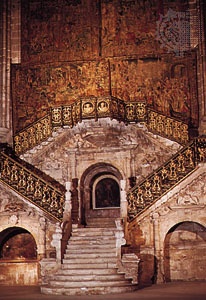Siloé, Diego de
Spanish artist
born c. 1495, Burgos, Spain
died October 22, 1563, Granada
 sculptor and architect (Western architecture) whose achievements are recognized as among the finest of the Spanish Renaissance. His sculpture is considered the high point of the Burgos Plateresque; his Granada Cathedral is considered the finest of all Plateresque buildings and one of the most magnificent of all cathedrals.
sculptor and architect (Western architecture) whose achievements are recognized as among the finest of the Spanish Renaissance. His sculpture is considered the high point of the Burgos Plateresque; his Granada Cathedral is considered the finest of all Plateresque buildings and one of the most magnificent of all cathedrals.The son of the sculptor Gil de Siloé (Siloé, Gil de), Diego probably studied sculpture in Florence. His first documented work is the Caraccioli Altarpiece (1514–15; San Giovanni a Carbonara, Naples), a product of his collaboration with Bartolomé Ordóñez. Returning to Burgos in 1519, he executed many designs for altarpieces and also the tower of Santa Maria del Campo. In April 1528 he left for Granada, where he designed the cathedral (1528–43) and executed many designs for churches and their sculptural decoration. He traveled to Sevilla (Seville), Toledo, and Salamanca as a consultant and designer.
Diego's sculptural style is a mixture of the Italian Renaissance, Gothic, and Mudéjar (Spanish Muslim) and is properly called Plateresque. Influenced by both Michelangelo and Donatello, he was able to animate his figures and create forceful compositions. His early masterpiece, the Escalera Dorada (Golden Staircase; 1519–23) in the Burgos Cathedral, combines both his sculptural and architectural gifts in a work of painted and gilded exuberance.
Diego's towering achievement is the Granada Cathedral. Wishing to build like the Romans, he adhered to the classical canon of the Italian Renaissance but created a work that combined the best features of the Renaissance, Gothic, and Mudéjar styles. His later churches, the Salvador church at Ubeda (1536), Guadix Cathedral (1549), and San Gabriel at Loja, all reflect elements of the design he perfected at Granada.